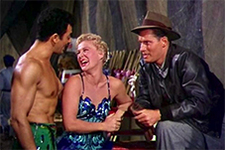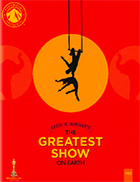The Greatest Show on Earth
|  Cecil B. DeMille’s penultimate spectacular The Greatest Show on Earth will likely forever be remembered as one of the least deserving Best Picture Oscar winners. Since the 1910s DeMille had been a popular director with a keen sense of audience desire and a willingness to go with whatever winds were blowing the strongest (how else to explain a filmmaker who was able to work so effectively in both censorship-flaunting sex farces and pious Biblical epics?). Many of his films also earned significant critical acclaim and awards, making him one of those rarefied Hollywood filmmakers who could achieve massive commercial and critical success. And, unlike many filmmakers whose careers fade out over time, he was arguably at his peak in his final years: prior to The Greatest Show on Earth winning the Best Picture Oscar and becoming the highest grossing film of 1952, he had delivered the biggest hit of 1949 with Samson and Delilah and then followed it with his last film, The Ten Commandments, the biggest hit of 1956 and the second highest grossing film of the decade. In other words, DeMille literally went out on top. Yet, there is still persistent grumbling about The Greatest Show on Earth’s Best Picture Oscar, especially since it is widely seen as coming at the expense of Fred Zinnemann’s masterful western High Noon and John Ford’s Irish romance The Quiet Man (not to mention the much beloved Singin’ in the Rain, which wasn’t even nominated for Best Picture). As Variety reporter Lawrence Christon noted in his article about the 1953 Academy Awards ceremony, which was the first to be broadcast on television, “the announcement that drew an audible gasp was Cecil B. DeMille’s ‘The Greatest Show on Earth’s’ best picture award. Though it was the top-grossing film of the year, bringing in $12 million … the smart money was on ‘High Noon,’ which had already won the New York Film Critics award. Nobody in the New York audience applauded. Viewers heard an indignant voice mutter—a recurrent question in Oscar history—‘Who votes for these things anyway?’” And there is good reason why there was indignant grumbling then and indignant grumbling now: The Greatest Show on Earth is not a particularly great film. It is not a bad film; in fact, it is filled with many pleasurable moments and maintains quite a bit of entertainment value, even if it begins to wane by the end of its overlong running time. It also has one of the greatest train collision sequences in Hollywood history, a self-contained masterpiece of miniature special effects that helps us to forget some of the lousy green-screen work in other parts of the film (and in especially weird places—did they really have to use optical effects to depict two men talking in front of a monkey exhibit?). Part of the film’s problem is that it is, in fact, two films awkwardly stitched together. The first film is a documentary about Ringling Bros. and Barnum & Bailey Circus, which provides the backdrop for the film’s drama. (More than a few people have suggested that the fabled circus company was all too happy to give DeMille unfettered access to their operation as a public relations gesture to help people forget the horror of eight years earlier, when 167 people died and 700 were injured in a big top fire in Hartford, Connecticut.) At least half of the film’s 153-minute running time is given over to documentary footage of the circus in action, which DeMille captured over a three-month period while the circus was on tour: trapeze artists swinging 40 feet in air, trained elephants marching, clowns clowning, seals dancing, parades of “exotic” cultures, and so on. There are also reams of footage of the extensive mechanics behind the circus, the laborious process of setting it up and tearing it down and loading it all onto train cars to go to the next town. DeMille himself, ever the showman, provides the breathless voice-over narration as we watch hundreds of men unrolling tons of fireproof tarp and erecting massive poles to raise the big top. There is genuine excitement in watching this massive operation unfold, although DeMille’s overly romantic narration is something of a hindrance, telling us over and over again in overly florid prose what we can clearly see on-screen (DeMille was nothing if not a practitioner of the excessive). The second film is a romantic drama that unfolds within the world of the circus in which the dedicated, no-nonsense circus manager, Brad Braden (Charlton Heston), finds his girlfriend, a trapeze artist named Holly (Betty Hutton), being wooed by The Great Sebastian (Cornel Wilde), a flamboyant French aerialist with a perfectly sculpted barrel chest and emerald green tights who has been recruited to give the circus a headline event to ensure a full eight-month schedule. Brad loves the circus itself more than he does Holly, while Sebastian, who is a legendary seduction artist, loves primarily himself. Brad also draws the eye of Angel (Gloria Grahame), who performs with the elephants and is the reluctant girlfriend of Klaus (Lyle Bettger), the obsessively jealous elephant trainer. There are also subplot involving Buttons (James Stewart), a clown with a hidden past, and a crooked midway dealer who is in cahoots with Mr. Henderson (Lawrence Tierney), a gangster whose threats are no match for Brad’s dedication to running a clean operation—at least initially. The screenplay by Fredric M. Frank (Samson and Delilah, The Ten Commandments), Barré Lyndon (The War of the Worlds), and Theodore St. John manages to keep these subplots relatively balanced, although they are regularly interrupted by DeMille’s extensive documentary footage of the circus, which would work much better if it were substantially shorter and therefore more clearly integrated into the drama, rather than creating a regular pause from it. The film’s best sequences involve Betty Hutton and Cornel Wilde 40 feet in the air performing their own stunts, something upon which DeMille insisted. Hutton was a multi-hyphenate star, having appeared on Broadway, signed a recording contract, and achieved leading star status in Preston Sturges’s The Miracle at Morgan’s Creek (1944) and musicals such as Annie Get Your Gun (1950). Wilde had been nominated for an Oscar for his role as the composer Frédéric Chopin in A Song to Remember (1945), but was best known as the muscular star of swashbucklers (he was on the cusp of leaving behind his status as a conventional Hollywood leading man to start his own production company and direct films himself). Heston, on the other hand, was a newcomer, having starred in only one Hollywood film, Dark City (1950), and a few television episodes. Although Heston was not DeMille’s first choice (he had wanted Kirk Douglas), he clearly recognized his square-jawed potential, which is why it is too bad that his character is something of a dullard, a man who is committed to his profession running the circus, but never expresses real passion. Yet, for all of its shortcomings, the sheer spectacle of The Greatest Show on Earth is not to be denied. As Bosley Crowther wondered in his fawning review in The New York Times, it is difficult to determine who deserves more credit for the film: DeMille or Ringling Brothers and Barnum & Bailey. It is the latter whose performers animate much of the screen time, which often makes the dramatics of the Hollywood stars seem like an intrusion. There is such genuine love for the circus itself and all it represented in mid-century America that you can’t help but admire it on some level, even as we now recognize all the awful practices that were employed (you wouldn’t know it from the film, though, where the animals are treated with dignity and care). As DeMille shows, there is plenty of room in the big top for all manner of entertainments, both large and small, and all those cut-aways to men, women, and children laughing and smiling and gazing in wonder or fear are surely his own fantasy of the ultimate movie audience enraptured by his latest spectacular.
Copyright © 2021 James Kendrick Thoughts? E-mail James Kendrick All images copyright © Paramount Home Entertainment | |||||||||||||||||||||||||||||
Overall Rating: 

 (2.5)
(2.5)


